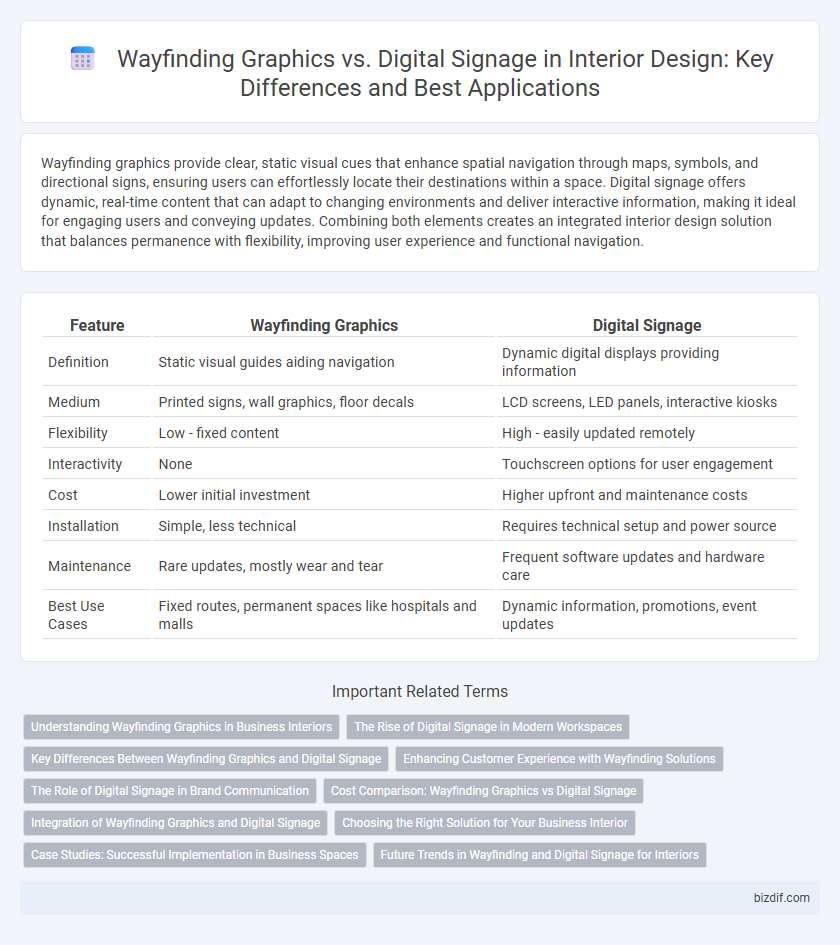Wayfinding graphics provide clear, static visual cues that enhance spatial navigation through maps, symbols, and directional signs, ensuring users can effortlessly locate their destinations within a space. Digital signage offers dynamic, real-time content that can adapt to changing environments and deliver interactive information, making it ideal for engaging users and conveying updates. Combining both elements creates an integrated interior design solution that balances permanence with flexibility, improving user experience and functional navigation.
Table of Comparison
| Feature | Wayfinding Graphics | Digital Signage |
|---|---|---|
| Definition | Static visual guides aiding navigation | Dynamic digital displays providing information |
| Medium | Printed signs, wall graphics, floor decals | LCD screens, LED panels, interactive kiosks |
| Flexibility | Low - fixed content | High - easily updated remotely |
| Interactivity | None | Touchscreen options for user engagement |
| Cost | Lower initial investment | Higher upfront and maintenance costs |
| Installation | Simple, less technical | Requires technical setup and power source |
| Maintenance | Rare updates, mostly wear and tear | Frequent software updates and hardware care |
| Best Use Cases | Fixed routes, permanent spaces like hospitals and malls | Dynamic information, promotions, event updates |
Understanding Wayfinding Graphics in Business Interiors
Wayfinding graphics in business interiors are essential for creating intuitive navigation paths, using visual cues like symbols, typography, and color coding to guide visitors effortlessly through spaces. Unlike digital signage, which serves dynamic content delivery and advertising functions, wayfinding graphics prioritize clarity and consistency to reduce confusion and enhance user experience. Effective implementation improves operational flow, increases safety, and elevates the overall aesthetic coherence of corporate environments.
The Rise of Digital Signage in Modern Workspaces
The rise of digital signage in modern workspaces has transformed wayfinding graphics by offering dynamic, real-time information that enhances navigation and user experience. Unlike static wayfinding graphics, digital signage integrates interactive elements and adaptable content, improving communication efficiency and reducing employee confusion. This shift reflects the growing demand for flexible, tech-driven solutions in contemporary office design, promoting seamless navigation and engagement.
Key Differences Between Wayfinding Graphics and Digital Signage
Wayfinding graphics utilize static visual elements like maps, symbols, and directional arrows to guide individuals through physical spaces by providing clear and intuitive navigation cues. Digital signage employs dynamic, screen-based displays that can show changing content such as videos, animations, and real-time information to engage viewers and communicate messages flexibly. The primary distinction lies in wayfinding graphics focusing on consistent, location-based guidance, while digital signage emphasizes versatile content delivery and interactive experiences.
Enhancing Customer Experience with Wayfinding Solutions
Wayfinding graphics provide clear, intuitive visual cues that help customers navigate complex interior spaces with ease, reducing frustration and improving overall satisfaction. Digital signage complements this by offering dynamic, real-time information that can be tailored to individual needs, enhancing engagement and accessibility. Together, these wayfinding solutions create a seamless, interactive environment that elevates the customer experience in retail, healthcare, and hospitality settings.
The Role of Digital Signage in Brand Communication
Digital signage plays a pivotal role in brand communication by delivering dynamic, visually engaging content that reinforces brand identity within interior spaces. Unlike traditional wayfinding graphics that primarily guide visitors, digital signage integrates multimedia elements such as videos, animations, and real-time updates to create immersive brand experiences. Enhanced flexibility and content customization enable businesses to adapt messaging instantly, strengthening brand presence and customer engagement in retail, hospitality, and corporate environments.
Cost Comparison: Wayfinding Graphics vs Digital Signage
Wayfinding graphics generally incur lower upfront costs due to simpler materials and fixed installation, making them budget-friendly for static navigation needs. Digital signage involves higher initial investments including hardware, software, and ongoing maintenance but offers dynamic content updates and remote management that can reduce long-term operational expenses. Businesses must weigh the cost of static durability against the flexibility and interactive potential of digital displays when choosing between these two wayfinding solutions.
Integration of Wayfinding Graphics and Digital Signage
Integrating wayfinding graphics with digital signage enhances spatial navigation by combining static directional visuals with dynamic, real-time information updates, improving user experience in complex environments such as hospitals and airports. Wayfinding graphics provide consistent, easy-to-read cues that maintain brand identity and accessibility standards, while digital signage offers flexibility through interactive maps, live event notifications, and emergency alerts. This seamless integration leverages complementary strengths to optimize orientation, engagement, and operational efficiency within interior design schemes.
Choosing the Right Solution for Your Business Interior
Wayfinding graphics provide clear, static directional cues that enhance navigation efficiency in business interiors, ideal for environments requiring minimal updates. Digital signage offers dynamic content flexibility, allowing real-time information changes and interactive features to engage customers and support branding. Selecting the right solution depends on your business's communication needs, budget constraints, and the desired level of user interaction within the space.
Case Studies: Successful Implementation in Business Spaces
Case studies in office and retail environments highlight that wayfinding graphics enhance spatial orientation through durable, easily interpretable visual cues, reducing visitor confusion and improving traffic flow. Digital signage offers dynamic content updates and interactive features, providing real-time information and personalized messaging that increases engagement and customer satisfaction. Businesses leveraging a hybrid approach achieve optimal impact by combining static wayfinding clarity with the flexibility of digital displays to address diverse navigational and promotional needs.
Future Trends in Wayfinding and Digital Signage for Interiors
Future trends in wayfinding graphics emphasize interactive and adaptive designs integrating augmented reality to enhance user navigation within interiors. Digital signage is evolving toward AI-driven content personalization and real-time data analytics to offer dynamic, context-aware messaging in public and commercial spaces. Combining both technologies enables seamless, immersive experiences that improve spatial orientation and engagement in complex interior environments.
Wayfinding graphics vs Digital signage Infographic

 bizdif.com
bizdif.com